► Model Y takes on the Germans
► Has Tesla gotten it all sewn up?
► Or has BMW or Merc toppled Elon?
Tesla’s used to getting its own way. But, after years of relative domination in the EV world, the ‘legacy’ car makers are catching up. How does the new Model Y fare against the box-fresh BMW iX1 and seven-seat Mercedes EQB?
Pre-flight briefing: BMW iX1
Why is it here?
The newest car in this test, it’s essentially an electric version of the current X1, in much the same way that the iX3 is the EV twin of the X3. It sort of replaces the i3 in the line-up, but only by being BMW’s entry-level EV; the i3 was electric-only and refreshingly different in many ways, whereas this is largely conventional, aside from some quirky aspects to the infotainment, now sadly sans iDrive.
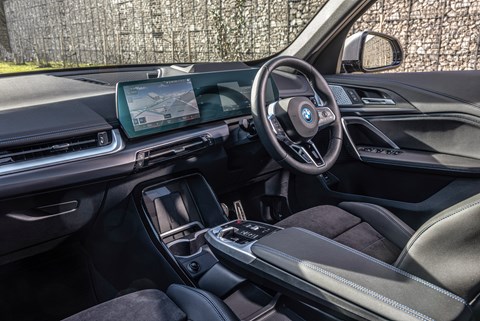
Any clever stuff?
The BMW offers you ‘Iconic Sounds’ while you’re driving. Put your foot down from a standstill and this turns out not to be The Who’s greatest hits but something more akin to a ’60s toy-shop space rocket with fresh batteries fitted. Quite what’s iconic about this defeats us. But hats off to BMW for not trying to make the electric iX1 sound like a combustion car through the use of sampled engine noises.
Which version is this?
The current iX1 line-up, priced from £53,295, is all about xDrive (signifying all-wheel drive) and 30 (not signifying much at all, but it will make sense if and when a cheaper 25 version arrives with a single motor and rear-wheel drive). There’s a choice of xLine or M Sport trim; we have the latter, with extra kit including 19-inch rather than 18-inch wheels.
Pre-flight briefing: Tesla Model Y
Why is it here?
Not only does Tesla still hold a long-established lead in powertrain technology, offering whiplash performance and outstanding range, but it’s also the only car here built on a bespoke EV platform. Hence better packaging and gargantuan loadspace.
Any clever stuff?
It’s all about the touchscreen. It has to be; there isn’t anything else to play with, so bad luck if you don’t care for the somewhat washed-out graphics and tiny speedometer read-out. But there’s so much information about the car’s immediate surroundings you needn’t bother looking out of the windscreen.
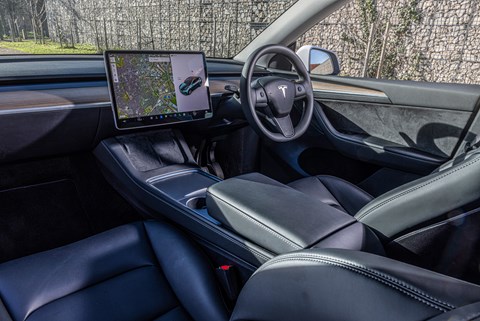
Which version is this?
It’s all in the name: Long Range Dual All Wheel Drive. There are also Standard Range Rear Wheel Drive and Performance All Wheel Drive versions of the Model Y, both similarly Ronseal. It’s worth noting, though, that such is Tesla’s head-start that the Standard Range version can still out-distance and out-perform many newer EVs. The Model Y is in essence a Model 3 swollen to appeal to SUV fans, with the roominess advantage and dynamic disadvantage that brings. Both are huge sellers, and recent UK price cuts mean that’s likely to persist.
Pre-flight briefing: Mercedes EQB
Why is it here?
Mercedes does premium better than almost anyone else, even if there is a hint of bling in the cabin. This is the least EV-like interior here, largely carried over from the combustion-engined GLB. And that makes it a doddle to live with.
Any clever stuff?
It’s a seven seater. If you don’t want to use the third row, fold them down and you have a usefully large boot. Other electric seven-seaters are either van-based or much more expensive cars, such as the Tesla Model X and Merc’s own EQS SUV. The feature is essentially a carry-over from the GLB, and as with that car it’s rather impressive that a vehicle with external dimensions well suited to negotiating supermarket car parks can also provide seats for a large family when required.
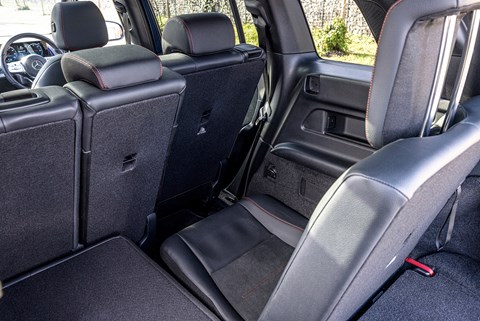
Which version is this?
The range starts at £55,310. All versions are all-wheel drive, and there’s just one battery size, but two power outputs and three trim levels. Our test car has the less powerful set-up, but on the road it’s potent enough. Our trim is the middle AMG Line Premium; don’t take the use of those three magic letters as an indication that AMG has breathed fire on it. But Premium describes the cabin environment to a tee.
Tesla Model Y vs BMW iX1 vs Mercedes EQB: Musk try harder
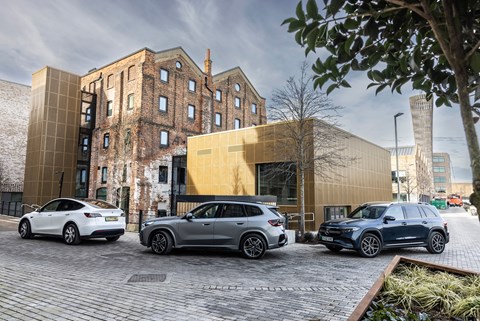
What constitutes the ingredients that persuade us to dub a car ‘premium’? And, moreover, will our perceptions of premium change as we glide haltingly towards the mechanised hum of another world? What – alarmingly elevated pricing aside – will we look for in an EV to grant it such revered status?
This is one of many questions accompanying the latest raft of EVs to the launch pad. Whatever happened to the design and packaging freedom we were promised with the advent of electric drive? And if we’re no longer to be enthralled by the sound of an exquisitely tuned engine at full chat, or the quest for the perfect downchange, what sensory alternatives will the future have to offer? Will it be fun? Will it even feel like driving any more…?
Well, let’s see if a couple of days enjoying the company of one of the newest EVs on the market and its two nearest rivals sheds any light. BMW’s iX1 xDrive30 M Sport and the Mercedes EQB 300 4Matic AMG Line Premium clearly tick the premium box, in that they’re very similar to the sort of combustion cars both companies have been making for generations. And several years spent leading the field in EV powertrain technology has earned Tesla – here in the shape of the Model Y Long Range Dual Motor All Wheel Drive – the right to be here, even if that elusive premium status is still open to question…
Large cooling-air inlets in the sides of the front bumper, a rear apron clad with faux diffuser, 19-inch alloy wheels and other M trim titbits identify this BMW iX1 as the M Sport model. Overall, it’s a look that some might call typically aggressive, sharp-suited BMW styling;
others might deem it an incoherent, shouty mishmash of slashes, creases, bulges and materials. You pays your money…
Save for a flourish of fancy lighting about the bows, the Mercedes
is entirely unremarkable to look at. As with the BMW, a blanked-out radiator grille identifies the EQB as an EV, and the only thing that
remotely catches the eye is a whisker of a flare at the hips for that cosy, matronly feel, and a little kink in the glasshouse sill to reflect that.
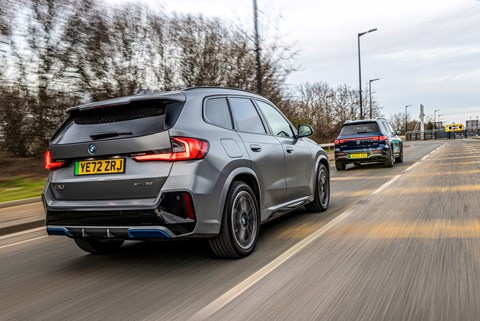
Oh, and, both BMW and Mercedes boast powered tailgates to add weight, as if we need that in machines that weigh over two tonnes.
With a whiff of a giant Sinclair C5 about it, the Tesla looks like something that’s been inadvertently brought to the surface in a trawler’s net from somewhere far below the depths to which daylight penetrates.
The bodyshell is almost entirely devoid of detailing, except for woeful panel gaps, and flush door handles in black to help you find them, even though they’re located exactly where you’d look for a door handle.
Entry is gained by either your suitably paired smartphone, or by a credit card key swiped over a particular point on the B pillar. That card can’t then stay in your pocket, however; you need to put it on the centre console behind the cupholders for the system to power up. Best not leave it there, though, because there’s no slot or pocket formed to hold it, and the first corner will send it sliding down between seat and console with resultant unpleasant bending and hot-fidgety fuss.
Both BMW and Mercedes keys (the former the size of an elephant suppository) are more practical affairs which may be left in the pocket throughout, in a properly premium manner.
On board, the two Teutons yell what we have come to accept as premium in their own inimitable styles. The EQB goes gently overboard on the turbine-aping styling of the air vents, and generally feels somewhat heavy on the bling factor. And although I happen to like the cabin background lighting after dark, a colleague described the effect as ‘tart’s boudoir; something Liberace would have loved.’
Increasingly ubiquitous twin dashboard screens are housed in the high-tech equivalent of a pizzaiolo’s oven paddle; standard fare with a driver’s instrument binnacle and a central touchscreen for infotainment. It’s sad to see a track pad controller installed in the centre console, even if its haptic operation is better than most. Touch-sensitive dimples on the steering wheel also give control of the screens.
The latter are easier to use than many touch systems I’ve come across, but the pad on the centre console relies on you being somewhat ambi-handstrous to use it left-handed with any panache, and it’s all too easy to succumb to stabbing the screen itself in the interests of greater accuracy and expediency. At least the most important menu elements are still accessible by a small flotilla of push buttons moored round the pad. What, though, is wrong with the original click-and-press wheel? This is supposed to be a premium car. I look forward to the day when premium buyers decide that proper switchgear is the true hallmark of a premium purchase. At least the Mercedes has the air-conditioning controls in a simple tab-operated panel. In all, the infotainment system’s pretty easy to navigate.
The EQB’s driving position gives no cause for complaint. With bolsters modelled on an amorous ray, the seat’s exceptionally comfortable despite, on this version, manual adjustment to both seat and steering wheel. Comfort in the rear seats is somewhat diminished by a high floor which brings occupants’ knees way above their hip points. And as for the third row (this is the sole seven-seater here) only small children need apply.
The BMW boasts the same double-screen pizza-paddle dashboard format as the Mercedes, though Munich has stuck with that hideous driver’s instrument graphic based on the geometry of the kidney grille. Here it’s even more angular than in combustion cars, presumably because electricity has sharper edges than fuel.
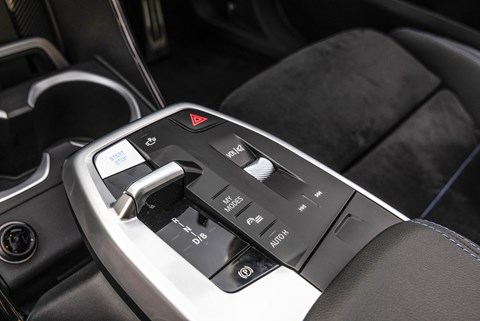
Having spent an eternity making it intelligible and intuitive to use, BMW has binned the iDrive controller. The company says this is because you’re close enough to the screen to touch it, so a console-mounted controller is superfluous. Um, this is not actually true unless you’re a gibbon. Those with a less simian reach will find themselves leaning forwards out of the seat to touch even the nearside of the screen. An ergonomic black mark, then, but score one for the bean counters.
The infotainment system is okay, but not as intuitive or clear as that of the Mercedes to use, with menus that are not so easy to surf or, sometimes, understand. But a phone charging slot is a bonus; it sits your phone just off the vertical at the front of the centre console, and there’s a bar you can push forward to hold it in place. Nice touch.
Air-conditioning controls are on the screen, but the front and rear demist buttons are tucked at the far end of the centre air vent. An odd location, and clearly not designed for right-hand-drive cars. Random. The flying centre armrest is a nice touch, but it’s actually only flying from the driver’s perspective; there’s a ruddy great spar holding it up on the front passenger side…
The consensus on the iX1 cabin was that it tries too hard to say ‘Hey, look at me, I’m smart and clever’. For me, the over-busyness is encapsulated by air-vent adjustment tabs with a grippy black top surface but a shiny, curved, brushed-metal underside, the whole barely deep enough to grab hold of, and a pointless gable-end graphic capping the head-up display; one more thing you don’t need or want in your line of sight.
The M Sport driver’s seat’s comfortable, albeit not quite as comfortable as the Merc’s. But the big fat M steering wheel rim isn’t. I’ve never warmed to it, even on cars where the performance merits the badge.
The Tesla interior, by contrast, is so barren that I wouldn’t be surprised to see tumbleweed barrelling across the dash. Minimal switchgear comprises a gearlever, an indicator stalk, and roller/rocker wheels on each side of the helm. The absence of cabin content some would say is the last word in high-tech, but I find it dull, sterile and frigid in atmosphere. The finishes are largely unappealing, most notably the wheel itself, which looks and feels horrible. No matter how superior in clarity and speed of operation the touchscreen may be (and it must be said that others are now catching up fast), the whole feels and looks decidedly un-premium.
The seating is merely acceptable, with not much to offer by way of either long-term comfort or support. There’s stacks of room in the back, though, and a huge boot, plus a front trunk; the benefits of packaging with a bespoke EV platform as a starting point.
It takes a while to get settled behind the wheel because you have to use the screen to adjust the rake and reach. Actually you have to use the screen to do everything. I’m reminded of the instructions-free Apple iPhone; it does all kinds of marvellous stuff that you have no idea about until another owner explains how to make it work…
Given there’s no driver’s instrument binnacle, the stuff you need to know – speed and range – is writ far too small on the screen; not legible out of the corner of the eye, so you have to look at it. And what’s with the element of the screen that shows you your environment, right down to traffic cones in roadworks? If someone approaches the car even that shows on the screen. But I don’t think the Tesla can differentiate between male and female forms. Yet…
The other downside of relentless touchscreen use is that, one Greggs sausage roll later, the surface quickly comes to resemble the disco floor after a gastropod dance marathon.
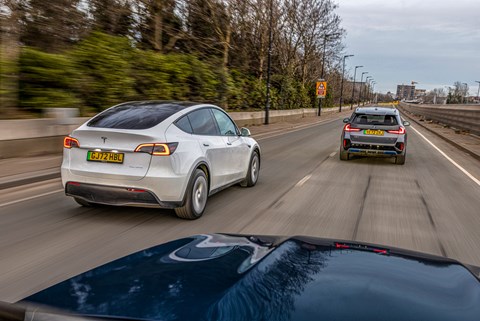
All three cars sport both front and rear electric motors to equip them with all-wheel drive. The BMW’s 64.7kWh battery is good for system power of 308bhp and 364lb ft of torque, and the promise of 0-62mph in 5.6 seconds and a 111mph top end. The 66.5kWh Mercedes battery promotes 225bhp, 273lb ft, 0-62mph in 7.7 seconds and just 99mph flat out. The Tesla’s 75kWh battery elicits a whopping 469bhp and 424lb ft of torque, which flings the Model Y to 62mph in 5.0 seconds, and on to 135mph.
Even the EQB, the slowest on paper here, hitches up its petticoats and pings off the line in the inimitable EV fashion of a golf ball fired out of a catapult. But both BMW and Mercedes fare less well when accelerating from a respectable cruising speed; only the Tesla shows any real inclination to power on from over 60mph with discernible vim.
The Mercedes offers three degrees of retardation available through the steering-wheel-mounted paddles, as has become the norm for EVs. I find the default mid setting a tad fierce for rural driving; slackening this off gives more of a freewheeling feel to throttle lift-off, in the manner of a standard automatic car.
Tightening things up, however, is fearsome indeed. The strongest setting will have your passenger retrieving their tonsils from the glovebox; retardation powerful enough to pretty much guarantee an emergency slop if you have a takeaway curry on the passenger seat.
It’s fine in an urban environment, though, but doesn’t bring you to a complete standstill, even with retardation dialled up to the maximum. The system leaves a little creep, just like an auto; not entirely one-pedal driving, but very user-friendly.
The combination of brake pedal and retardation also works better in the default setting or above. It can be clumsy when you rely over much on retardation for stopping and then apply the brakes as well.
The Tesla also offers three-step adjustable retardation, but insists that you use the touchscreen to change between settings, and will not allow you to do so unless the transmission is in Park. So you’ll need to pull over every time you enter an urban environment, unless you’re quick off the mark at traffic lights. Retardation at full strength does bring the car to a stop.
The BMW has a choice of braking levels, but it’s not set via the one flappy paddle on the helm; that’s there to trigger 10 seconds of boost, which you’ll need to hit 62mph from a standstill in the quoted time.
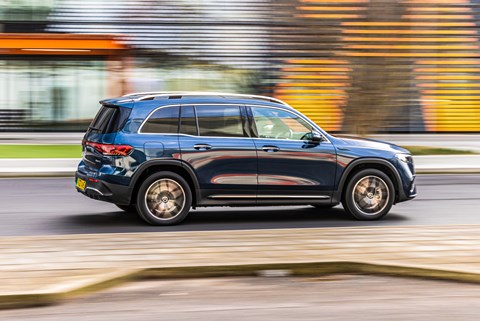
At speed, all the noise aboard the Mercedes is tyre roar, and the occasional susurration of wind assaulting the door mirrors. EQB ride quality is the pick of the bunch; supple, quiet and nicely damped. Yet the car will still corner with some alacrity. The steering is typical Mercedes; not a huge amount of feel, but nicely weighted and perfectly accurate. And somehow the EQB seems to have best resolved the relationship between front and back ends, and they work in greater harmony than those of either the Tesla or, surprisingly, the BMW; neat, tidy and unfussy handling for a 2.1-tonne SUV.
The iX1’s ride is a tad firmer than that of the Mercedes, and not quite so well insulated from road noise. The steering feels more engaging than the EQB’s, and not quite so frantic as the Tesla’s. However, throw the BMW into tighter corners and I’m not convinced it is any more capable than the Mercedes. The front tyres feel as if they’re scrubbing into the beginnings of understeer quite early, despite all-wheel drive, and there seems to be a disconnect between front and rear axles. The Mercedes is much more composed and less prone to moan.
Alas, the Tesla’s ride quality is shocking; cart springs and concrete damping – right up there with a shopping trolley on corrugated iron, and the sound enters the cabin with a gusto that would impress even the Kodo drummers. Worse still, build quality is sufficiently suspect that the interior creaks and groans its way down the road like a galleon in a gale. The steering has a nasty stodgy quality top dead centre and then is instantly too quick and rather darty.
It may go like a stabbed rat, but the Model Y also has all the charm of one. Quick, but not very pleasant. And if we’re judging these as premium products, that’s not ideal.
Tesla Model Y vs BMW iX1 vs Mercedes EQB: the final reckoning
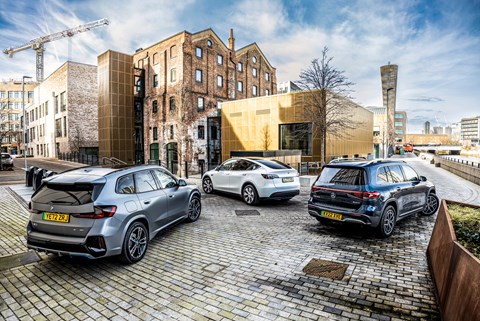
The first issue raised by anyone interested in an EV is range. There’s near parity between the BMW and the Mercedes, but the Tesla’s way out on its own.
Both the Teutons returned 3.2 miles per kWh on our EV test route, and the Tesla a handsome 3.9. However, an average taken over a 220-mile journey involving a good chunk of motorway tells a different tale: both BMW and Mercedes managed 2.7 miles per kWh, and the Tesla 3.2. But at 70mph on a cold day, the range of both German machines plummeted like an anvil kicked off a cliff. So much so, in fact, that both required a half-hour top-up on a 50kW charger before they could complete the journey home.
With a tested range of 195 miles and 200 miles respectively, then, both Mercedes and BMW came up some 50-60 miles short of their quoted ranges. The Tesla, meanwhile, much vaunted for its capacity to stay clear of the charging post, came up nearly 100 miles short of its quoted capability…
Pricewise, there is once again near parity between the BMW and Mercedes; £55k and £56k respectively. With recent price cuts across the board, Tesla’s Long Range Dual Motor Model Y undercuts both at £52,000, before the optional self-driving capability bumps it up to nearly 60 grand. (But we’d think twice before shelling out for something that’s fiendishly complicated to develop, requires regulatory approval and has no concrete introduction date.)
Waters thus muddied, picking a winner isn’t easy, and I’m grateful for the consensus of the two grizzled veterans of road test adjudication with whom I shared our travels. Of the Tesla, one said: ‘The cabin leaves me cold – it might be cool and exciting to many but I think it shows just how low down the list of priorities the driver is; an unimportant part of any journey. I’d rather be having a coffee while waiting for either the BMW or Mercedes to recharge than travel a further 45 miles in the Tesla.’
The other opined: ‘The Tesla’s performance and handling are perkily entertaining, and its range makes up for many of its flaws.’ It’s still clobbered by the cold weather, but the bigger battery ultimately gives it a significant advantage.
If its range suits your circumstances, the Mercedes wins this test. It may not be much to look at, but it impresses at almost every level, is easy to live with, and oozes premium feel.
Tesla Model Y vs BMW iX1 vs Mercedes EQB: the verdict
First place
Mercedes EQB
Comfortable, quiet, pleasant to drive and fast enough. Easy to live with, too.
Second place
BMW iX1
Comfortable and quick, but ride occasionally brittle, and that bit too brash and flash for some.
Third place
Tesla Model Y
Powertrain pick of the bunch, and clever packaging. But build quality, ride quality and interior finish are woeful.